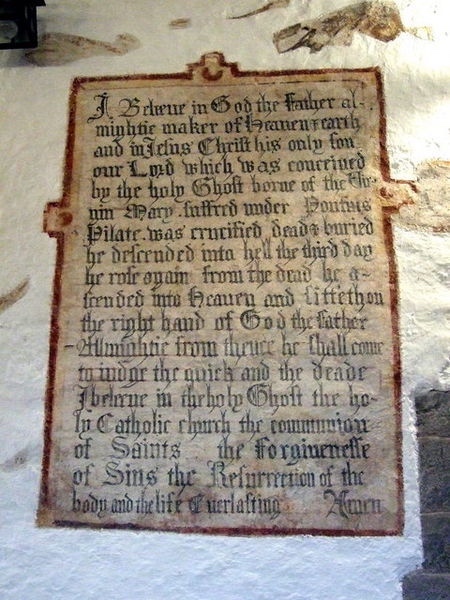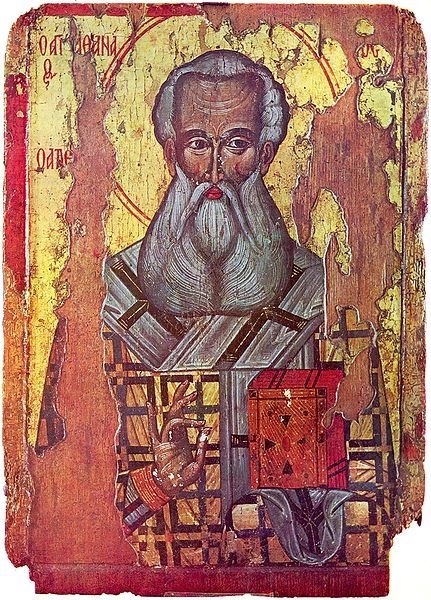2 教會的信經

使徒信經
Medieval tradition held that the Apostles’ Creed was composed by The Twelve on the Day of Pentecost–hence the name 「Apostles’ Creed.」 Though certain aspects of the creed may suggest late-first or early-second century origins, today it is generally agreed that a fourth-century date is most likely. The first reference to the Apostles’ Creed comes in a letter from the Council of Milan in the year 390. It is considered a baptismal creed since it is used in that rite and is one of the most basic statements of the Christian faith.
我信上帝、全能的父、是創造天地的。
我信我主耶穌基督、是上帝的獨生子。因聖靈降孕、為童貞女馬利亞所生。在本丟彼拉多手下受難、釘在十字架上、受死、埋葬。降在陰間、第三天從死裏復活。升天、坐在無所不能的上帝聖父的右邊。將來必從那裏降臨、審判活人死人。
我信聖靈。我信聖而公之教會。我信聖徒相通。我信罪得赦免。我信身體復活。我信永生。 阿們。
尼吉亞信經
The First Council of Nicea rejected the heresy of Arianism, which held that Christ is a creature, less than God the Father. The orthodox, led by St. Athanasius taught that Christ is ‘of one substance (homoousios) with the Father’ and ‘God of God, light of light, very God of very God’, ‘begotten not made’, to battle the views of the Arians. According to Athanasius, ‘there never was a was when the Son was not’. Or to put it another way, if the Father is eternal, the Son must be co-eternal with him, since a father is not a father without a son.
The debate at and after Nicaea revolved around the word homoousios, which does not occur in Scripture. The Arians used the word homoiousios, ‘of similar substance’, to define their belief. The creed of this Council forms the core of our Nicene Creed, but the full text that we now use was produced by the next Council (with the exception of one word, filioque, ‘and the Son’, added later), so scholars usually call the creed the Nicene-Constantinopolitan Creed.
我信獨一上帝全能的父、是創造天地的、並造有形無形的萬物。
我信獨一主耶穌基督、上帝的獨生子、在萬世以前、為父所生、是從上帝的上帝、從光的光、從真上帝的真上帝、且生不受造、與父一性、萬物都藉着他受造。又為我們世人、為救我們、從天降臨、因聖靈降孕、從童貞女馬利亞取肉身、成為世人。在本丟彼拉多手下、為我們釘在十字架上、受害、埋葬。照聖經的話、第三天覆活。升天、坐在父的右邊。將來必駕威榮再臨、審判活人死人、他的國就沒有窮盡。
我信聖靈、是主、是賜生命的、從父子出來、同父子一樣受尊貴、一樣受頌美、往日藉着眾先知傳話。我信使徒所傳的惟一聖而公之教會。我承認為赦罪設立的獨一洗禮。我望死人的復活。又指望來世的永生。 阿們。
亞他那修信經
The Athanasian Creed is one of the three great Creeds of the Church, and as such is printed in most editions of the Prayer Book, though not in the American Prayer Books. The omission of the Athanasian Creed from the American book may have had something to do with the influence of anti-Trinitarian Deism in the 18th century and probably even more to do with an uneasiness concerning its so-called ‘damnatory clauses’. However, as the preface to the American Prayer Book asserts an identity of doctrine with the Church of England, which does use the Athanasian Creed, there was never any question of a formal rejection of the Athanasian Creed. As for the damnatory clauses, they may be understood as directed mainly against traitors to the faith or apostates (those who fail to keep the faith), rather than as a condemnation of those who have never had the opportunity to embrace or hear the gospel. In any case, the status of the Athanasian Creed is acknowledged by the Affirmation of Saint Louis and by the Constitution and Canons of the Anglican Catholic Church.

A 16th century icon of St. Athanasius, supposed author of the Athanasian Creed. As the Apostles’ Creed was not in fact authored by the Apostles, and the Nicene Creed as it now stands was actually the product of the Council of Constantinople, not the Council of Nicaea, so too the Athanasian Creed was not authored by Saint Athanasius. In each case, however, the creed in question does present the faith of the nominal author, so the traditional titles are fitting if somewhat historically inexact. In the Athanasian Creed the divinity of Christ, and his oneness of substance with the Father, as taught by Athanasius, are clearly asserted.
The Athanasian Creed in fact probably dates to the late-fifth century. Although this creed has dogmatic authority as well as a place in the liturgy of the Roman Catholic Church, and is respected in the Eastern Church, its place in the Anglican Church is uniquely high. This unique position comes from the fact that the English and most other Prayer Books direct that the Athanasian Creed be recited publicly in Morning Prayer on a dozen or so great feasts. Since Morning Prayer in turn was often the chief popular service on most of those feasts, Anglican laymen said or sang this creed with unparalleled frequency. In contrast in the Roman Church the Athanasian Creed was generally only recited occasionally in Latin by clergy or religious in one of the daily Offices, and so was not widely known by laymen.
The Athanasian Creed is also called the Quicunque vult, from the first words of its Latin translation. The Prayer Book translation of the text is printed as a canticle or hymn in the Prayer Books.
- 凡欲得救者、首先須當持守屬公會之道。
- 此道、凡守之不全、守之不純者、必致永遠沉淪。
- 屬公會之道、載下、我等敬拜獨一天主為三位、又敬拜三位為一天主。
- 其位不紊、其體不分。
- 蓋聖父一位、聖子一位、聖靈亦一位。
- 然聖父之為天主、聖子之為天主、聖靈之為天主、其性為一、榮光同等、威嚴同是永遠。
- 聖父如是、聖子如是、聖靈亦如是。
- 聖父非受造、聖子非受造、聖靈亦非受造。
- 聖父無限量、聖子無限量、聖靈亦無限量。
- 聖父無始終、聖子無始終、聖靈亦無始終。
- 非三無始終、乃一無始終。
- 亦非三不受造、非三無限量、乃一非受造、一無限量。
- 聖父全能、聖子全能、聖靈亦全能。
- 非三全能、乃一全能。
- 聖父是天主、聖子是天主、聖靈亦是天主。
- 非三天主、乃一天主。
- 聖父是主、聖子是主、聖靈亦是主。
- 非三主、乃一主。
- 依屬主基督教之實情、我等不得不認三位各自為天主、各自為主。
- 如是、依屬公會之道、我等不得謂天主有三、亦不得謂主有三。
- 聖父無所由成、非受造、亦非生。
- 聖子獨由聖父、非受成、非受造、乃由聖父而生。
- 聖靈由聖父與聖子、非受成、非受造、亦非生、乃由出。
- 如是、有一聖父、非三聖父、有一聖子、非三聖子、有一聖靈、非三聖靈。
- 此三位一體之中、無先後、無尊卑之別。
- 乃三位皆互相永遠同在、並同等。
- 如是、由上所論、一天主為三位、三位為一天主、乃當敬拜。
- 凡欲得救者、當如是、顧三位一體之天主。
- 再者、凡欲得永救、又必須依正道、信吾主耶穌基督成為人身。
- 依此正道、我等信認吾主耶穌基督、天主之子是天主亦是人。
- 其為天主、以其由聖父之體生於萬物之先,其為人、以其由母之體生於世間。
- 其真為天主、亦真為人、靈心與肉軀全備。
- 論其天主之性、與聖父同等、論其人之性、則次於聖父。
- 其為天主亦為人、然不可稱為二、惟一基督。
- 其為一、非天主之性變為肉身、乃天主取人性而成一位。
- 其真為一、非在體之相紊、乃在位之為一。
- 蓋靈心與肉身相合為一人、天主與人相合為一基督、亦若是。
- 其為救我等而受難、降於陰間、第三日從死復活。
- 升天、坐於天主全能聖父之右、後必自彼處降臨、審判活人死人。
- 降臨之時、萬人必以身體復活、並且陳明本身所行之事。
- 行善者必入永生、行惡者必入永火。
- 此乃屬公會之道、凡不依正道篤信者、必不能得救。
但願榮耀歸於聖父、聖子、聖靈。 起初如此、現今如此、以後亦如此、世世無盡。 阿們。